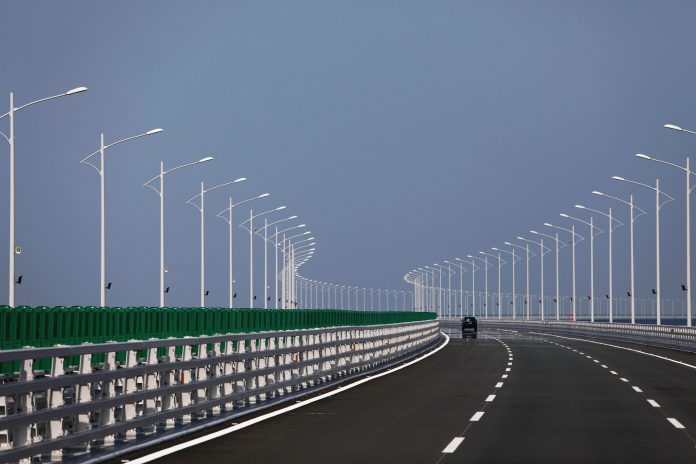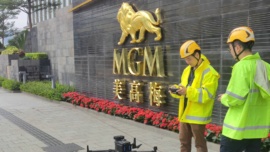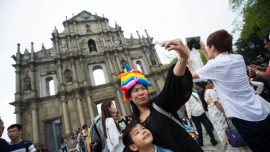“Many citizens have been under the impression that these procedures were purposely implemented to prevent the circulation of vehicles and people”. One thing is certain: the complicated bureaucracy behind using the bridge does not help increasing its circulation. Is this the goal?
MB November Special Report | The ghost bridge
Does the bridge have low usage? Throughout this special report we have seen a number of contributing factors, but one more has yet to be added – the difficult bureaucracy makes many of the potential stakeholders opt to use the buses instead.
Take this example:
Hong Kong users wishing to use the bridge and park at the artificial island silo have to mark this place 30 days in advance, and procedures must be completed within 12 hours prior to the actual use.
No wonder then that in the first six months only 11,800 Hong Kong private vehicles used the auto silo, which means less than 60 cars a day.
This long booking period has been reduced to 6 hours from 1 April 2012.
“In order to increase efficiency and facilitate the use of the auto silo, after hearing the Customs Services and the Public Security Police Corps, the minimum advance has been reduced to 6 hours, with a view to stabilizing the use of the auto-silo and in order to avoid traffic jams in Macau”, says a report by members of the Legislative Assembly, who monitor the operation of the bridge.
The same document admits that “reducing the advance appointment time to one hour in order to increase the usage rate of the silo” however is not a priority, and is dependent on the “progress of the study and the improvement of the system through the new technologies”.
Nevertheless, car parks in the Hong Kong checkpoint keeps the statutory 12 hours for booking.
“In the long run there is possibility that all cars from Macau and Hong Kong will be able to use the bridge” – Yu Lie

Another big bureaucratic issue is registration, especially for Macau cars entering Hong Kong and Zhuhai, which need to post three registrations simultaneously, which is not the case with private vehicles arriving from Hong Kong. Since the situation has been virtually resolved, DSAT has invented a license plate recognition system for the three locations, which was installed on the border line of the Macau post and is automatically operates to identify vehicles entering the MSAR.
“Many citizens have been under the impression that these procedures were purposely implemented to prevent the circulation of vehicles and people”, is the opinion of Congressman Pereira Coutinho, for whom the need for advance booking to use the car parks is “yet another among the many nonsense bureaucracies implemented”, a situation that, in this legislator’s view, “discourages people from using the bridge”.
The truth is that in a situation with these characteristics – involving three destinations with different rules and autonomy – bureaucracy is everywhere.
To keep out the large number of Chinese tourists, Hong Kong has now limited the number of seats on buses.
Thousands of people were forced to enter Macau without their initial intention, causing congestion (as seen on 7 February, third day of Chinese New Year holidays, with 226,326 visitor arrivals).
What did Chinese authorities say about this?
“After an initial period, an assessment will have to be made, and increasing the number of quotas is a possibility”, admitted Yu Lie, deputy director of the bridge authority a few months ago, adding: “But because of the current ‘one country, two systems’ policy, and of the different traffic rules, this is a preliminary process. We have to wait for the Great Bay Area project to be implemented”. He also said that “in the long run there is possibility that all cars from Macau and Hong Kong will be able to use the bridge”.
Three car insurance
The bridge is only one but at each of the three ends there are different laws and rules.
It is true that in Macau, Hong Kong and Zhuhai it is compulsory for vehicles to have valid auto insurance, but will three different insurance policies be required because of this?
Reality shows that this will in fact be the case, since the policy of each location cannot meet the laws in force at all three locations at the same time – Hong Kong law requires a minimum insurance amount of no less than MOP 100 million for accident coverage, while in China the minimum value is Y$ 122,000 and in Macau the value varies depending on the type of vehicle (MOP 1.5 million for a light passenger).
Result: Before going on the road, the owner must purchase legal auto insurance at the destination.
While the obvious solution, which is the possibility of having only one insurance with uniform conditions, is being devised with the aim to be found as soon as possible, one step has been taken to facilitate the purchase of insurance for the destination through one-stop services in any of the three locations.
























